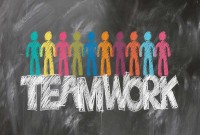- Home
- Business Processes
- Industry Knowledge
- Aerospace Industry
- Automotive Industry
- Banking Domain
- BFSI Industry
- Consumer/ FMCG Industry
- Chemicals Industry
- Engineering & Construction
- Energy Industry
- Education Domain
- Finance Domain
- Hospitality Domain
- Healthcare Industry
- Insurance Domain
- Retail Industry
- Travel and Tourism Domain
- Telecom Industry
- Leadership Skills
- eLearning
- Home
- Leadership
- Decision Making
- Benefits of Teams in Workplace
Benefits of Teams in Workplace
The use of formal work teams is commonplace in modern organizations. But why we have teams? What are the benefits or advantages that teams provide for organizations and employees? Do we really need to adopt formal team structures and use team-building approaches in organizations? Read this article to explore and learn the benefits of having formal teams in organizations.
There exist several organizational and individual benefits of using teams. These include increased workplace productivity; improvements to product/service quality; a reduced management structure; lower levels of absenteeism; reduced employee turnover; and increased industrial harmony, with all these benefits ultimately leading to improved workplace performance. It also enhances the quality of work-life (QWL) for employees and leads to increased work satisfaction. Teams are found in many workplace environments, including corporate, government, and education because they allow the organization to:
Organizational Benefits of Teams:
1. Workplace Productivity:
Having structured teams eliminate problems, waste and errors by removing variation in the work system by bringing individuals together to resolve work-system problems. The removal of variation in the work system produces a more productive system. Teams ensure that the work continues in the absence of a human ‘part’ by building ‘redundancy of parts’. This ensures that the system will not malfunction due to the absenteeism of any individual employee and will continue to perform without interruptions. Hence the organizations adopting team structures will have a higher level of labor productivity than firms that do not have these team structures.
2. Product/Service Quality:
As teams function to remove variation from a working system, resulting in the output being consistent and reliable. For example, in a production line work structure, employees focus on their individual ‘part’ in the system with quality generally inspected at the end of the production line. In the case of teams, a group of workers attends to whole tasks thereby ‘empowering’ such workers to take responsibility for their work and adjust work processes to improve the quality of their output. Hence the quality gets effectively ‘built-in’ to the process and therefore the organizations adopting team structure will gain higher levels of product/service quality than firms that do not have these team structures.
3. Lower Cost Management Structures:
By having teams, the responsibility for resolving work problems becomes collective and there is less need for external supervision. This reduced need for external supervision may result in a reduced number of levels in the hierarchy.
4. Lower Absenteeism:
Team structures provide an increased level of autonomy and responsibility and employees enjoying the social structure of teams are more likely to attend work. Thus, organizations with team structures will have lower absenteeism than firms that do not have these team structures.
5. Employee Turnover:
As with absenteeism, the social structure of teams is reported to positively impact employee turnover. If the quality of work-life is improved for employees when teams are present then a reduction in employee turnover is a likely outcome.
6. Industrial Harmony:
Teams actively encourage employees to present the results of problem analysis to management for approval regarding proposed solutions and this encourages improved labor-management interactions. Hence teams enable employees to have a closer working relationship with management which enables firms with these team structures to have a higher level of industrial harmony than firms that do not have these team structures.
7. Accomplish Big/Complicated Tasks:
Many organizational tasks and projects are too huge for an individual to do independently. Having team structures ensure that individual geniuses of the persons are collectively used and mammoth tasks are completed.
8. Brainstorm More Solution Options:
Different people looking at the same problem will find different solutions. A team can review ideas and put together a final solution that incorporates the best individual ideas. They can generate commitment for the final solution and work together to collectively pursue the same.
9. Review/Detect Flaws:
A team looking at different proposed solutions may also be in a better position to catch pitfalls that an individual might miss. This ensures that the final solution is much stronger and qualitative.
10. Build a Workplace Community:
Members of effective teams can form personal bonds which are good for individual and workplace morale. In the organizational setting, employees on teams may form bonds that extend beyond the work-place.
Individual Benefits of Teams:
1. Diversity:
Team structures provide exposure to different points of view. As the employees get exposed to methods and ideas that others have, they learn different ways of approaching a problem.
2. Enhanced Communication Skills:
Through teamwork training and practice, employees learn to actively and effectively listen to their team members to understand their viewpoints and concerns. A member needs to effectively articulate his ideas or your concerns to others to ensure they are taken care of or addressed. Members get genuine constructive feedback from each other and develop presentations, negotiating, and other related communication skills.
3. Critical Thinking and Evaluation Skills:
Team members must use these skills to evaluate the complex issues of team project goals and to formulate appropriate solutions and plans.
4. Conflict Resolution Skills:
Where there exists a diversity of ideas, there will naturally exist conflicts, but, with the right support and training in communication skills, team members can learn the skills to facilitate solutions to conflicts so that the team remains functional.
5. Higher Moral/Less Stress:
When things on the team are functioning well, it often results in higher morale and less stress at a personal level. Teams provide social support to team members and they can take help from each other in case of complex issues or other workplace-related problems.
Related Links
You May Also Like
-
The development of teams is an ongoing process because the composition of the team may keep on changing. The new members may join and the old members may leave the team. The team members pass through several stages for the development of the team and there has been a lot of research to identify these stages. In this article, we discuss the common theories of team development.
-
Authentic leadership is an approach to leadership that emphasizes building the leader's legitimacy through honest relationships with followers which value their input and are built on an ethical foundation. The authentic leader acts upon his or her values and beliefs, and inspires others to do the same, is committed to know and develop oneself. Are you committed to developing yourself; know your motivations and the purpose of your leadership? Read this article to know more about authentic leadership style and discovering your authentic self.
-
Effective Business Communication
Communication is all about getting the message across correctly. To make this happen, you need to have good speaking skills and good writing skills. If you have these skills coupled with good listening skills and interest in reading, you have all the potential to be a good communicator. What things should the leader take into consideration to be more effective with interpersonal communication?
-
Concept & Definition of Stress
Stress is a popular expression used by people in day to day life. Pressures of day to day living sometimes necessitate coping or dealing with them and stretch the body beyond its natural capacity. They are called stressors. Stress is a natural, ongoing dynamic, and interactive process that takes place as people adjust to their environment.
-
“Level 5 Leadership”, this term was coined by Jim Collins in his book “Good to Great” and it is all about achieving "Greatness" as a leader. This article will explain what we mean by Level 5 Leadership and what the characteristics of a Level 5 leader are. What it takes to achieve greatness as a leader, and what are the steps and strategies that one can use to move up to this top level of leadership.
-
Many different types of teams have been identified by social scientists. Managers may encounter the diverse types of challenges while managing different kinds of teams. Challenges associated with Cross-Functional Teams might be different from that of a Geographically Dispersed Team or a Virtual Team. This article explores some common categories and subtypes of teams.
-
In its simplest sense, decision-making is the act of choosing between two or more courses of action. Decision making is a key skill in the workplace and is particularly important if you want to be an effective leader. When decisions have to be made, there are several stages that you should go through to reach a practical solution. Understand the meaning and importance of decision making and how to look at it as a process.
-
Teams are part of the modern organizational culture. Whether you are a team leader or a team member, having a better understanding of how teams work, and being able to identify where the team is in the process, is a critical part of ensuring the team is ultimately successful. Start with the basics and understand what a team is and what role they play in an organization.
-
Team leadership theory is a recent leadership theory that does not discriminate between the leader and the other team members. The approach considers contributions from each team member to be critical for organizational success. This approach focused on the overall team effectiveness and team problems are diagnosed and action is taken to remediate weakness. This approach provides for taking corrective action when the leader deems necessary.
-
How often do you have a plan for how you are going to spend your day but you aren't able to complete the tasks on your plan because of unimportant tasks, interruptions, or your own procrastination? Wouldn't it be great to be able to manage your schedule and your time while avoiding, or at least controlling, these time stealers? Learn the strategies to manage your schedule while still handling interruptions and demands on your time.
Explore Our Free Training Articles or
Sign Up to Start With Our eLearning Courses

About Us
Learning
© 2023 TechnoFunc, All Rights Reserved










